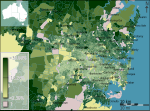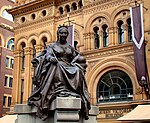St Andrew's Cathedral, Sydney

St Andrew's Cathedral (also known as St Andrew's Anglican Cathedral) is a cathedral church of the Anglican Diocese of Sydney in the Anglican Church of Australia. The cathedral is the seat of the Anglican Archbishop of Sydney and Metropolitan of New South Wales (currently the Most Reverend Kanishka Raffel from 28 May 2021). The position of Dean of Sydney has been held by the Very Reverend Sandy Grant since 9 December 2021. The St Andrew's has an Evangelical ministry, holding services every day, including a weekly healing service. There is a cathedral choir of men and boys who sing during term time, as well as a company of bell ringers. The notable pipe organ has been restored and is regularly used for recitals and concerts. Designed primarily by Edmund Blacket on foundations laid by James Hume, the cathedral was built from 1837 to 1868, and was ready for services and consecrated in 1868, making it the oldest cathedral in Australia. St Andrew's is one of the city's finest examples of Gothic Revival architecture. Joan Kerr described the cathedral as "a perfect example of the colonial desire to reproduce England in Australia in the mid nineteenth century".The cathedral is located at 1400 George Street in the Sydney central business district of the City of Sydney local government area of New South Wales. St Andrew's is owned by the Anglican Church Property Trust. It was added to the New South Wales State Heritage Register on 3 September 2004; is listed on the City of Sydney local government heritage register; and is listed on the (now defunct) Register of the National Estate.
Excerpt from the Wikipedia article St Andrew's Cathedral, Sydney (License: CC BY-SA 3.0, Authors, Images).St Andrew's Cathedral, Sydney
Saint Andrews Place, Sydney Sydney
Geographical coordinates (GPS) Address External links Nearby Places Show on map
Geographical coordinates (GPS)
| Latitude | Longitude |
|---|---|
| N -33.873923 ° | E 151.206336 ° |
Address
St Andrews Cathedral
Saint Andrews Place
2000 Sydney, Sydney
New South Wales, Australia
Open on Google Maps








